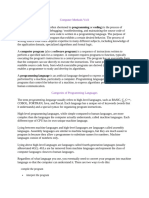0 ratings0% found this document useful (0 votes)
5 viewsC_Programming_Guide
This is the guide for c program
Uploaded by
malikshadan430Copyright
© © All Rights Reserved
We take content rights seriously. If you suspect this is your content, claim it here.
Available Formats
Download as PDF, TXT or read online on Scribd
0 ratings0% found this document useful (0 votes)
5 viewsC_Programming_Guide
This is the guide for c program
Uploaded by
malikshadan430Copyright
© © All Rights Reserved
We take content rights seriously. If you suspect this is your content, claim it here.
Available Formats
Download as PDF, TXT or read online on Scribd
You are on page 1/ 2
C Programming - Comprehensive Guide with Examples
History and Introduction to C Programming
C is a general-purpose programming language developed by Dennis Ritchie at Bell Labs in 1972. It
is known for its efficiency, portability, and flexibility, which makes it widely used in system
programming, embedded systems, and software development. C influenced many modern
programming languages like C++, Java, and Python.
Structure of a C Program:
A typical C program consists of:
1. Preprocessor directives
2. main() function
3. Variable declarations
4. Statements and expressions
5. Functions
Example:
#include<stdio.h>
int main() {
printf("Hello, World!");
return 0;
Compilation and Execution of C Programs
Compilation involves converting the source code into machine code using a compiler.
Steps:
1. Write the code in a .c file.
2. Use a compiler (e.g., GCC) to compile: gcc program.c -o program
3. Execute the binary: ./program
Debugging Techniques:
1. Use a debugger like gdb.
2. Insert print statements to track values.
3. Check for logical errors and memory leaks.
Data Types, Variables, and Modifiers
Data Types:
1. int - Integer (e.g., int age = 25;)
2. float - Floating-point number (e.g., float pi = 3.14;)
3. char - Character (e.g., char grade = 'A';)
4. double - Double precision floating-point number.
Declaration of Variables:
Variables must be declared before use.
Example:
int x;
float y = 5.5;
Modifiers:
Used to change the size or range of a variable (e.g., unsigned, short, long).
You might also like
- C Programming Wizardry: From Zero to Hero in 10 Days: Programming Prodigy: From Novice to Virtuoso in 10 DaysFrom EverandC Programming Wizardry: From Zero to Hero in 10 Days: Programming Prodigy: From Novice to Virtuoso in 10 DaysNo ratings yet
- Introduction To C Programming PresentationNo ratings yetIntroduction To C Programming Presentation10 pages
- Explain The Topic Introduction To C Programming A...No ratings yetExplain The Topic Introduction To C Programming A...2 pages
- C Programming - Lecture Notes (Till Format Specifiers)No ratings yetC Programming - Lecture Notes (Till Format Specifiers)61 pages
- slidesgo-mastering-c-programming-a-comprehensive-guide-for-beginners-20250203105640qvFaNo ratings yetslidesgo-mastering-c-programming-a-comprehensive-guide-for-beginners-20250203105640qvFa8 pages
- Unit 1 - Programming Fundamental of C (12th February 2025)No ratings yetUnit 1 - Programming Fundamental of C (12th February 2025)60 pages
- Lecture 1: Introduction of Electrical PrincipleNo ratings yetLecture 1: Introduction of Electrical Principle12 pages



























































